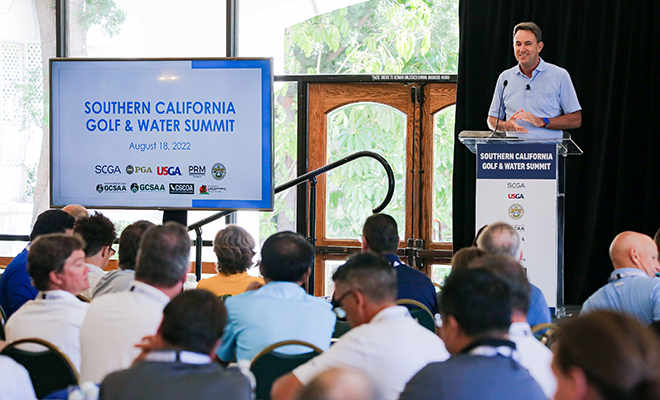Strength in Numbers: Valuing Communities Over Dollars

When asked what the SCGA Public Affairs Department does, my answer is a simple one. SCGA Public Affairs operates in all the places where golf and public policy intersect. And it “operates” to seek what the politics strike us as the game’s best possible outcome in each instance.
Two “simple” principles that encompass a complexity that few understand and even fewer want to understand. But those who earn their keep securing those best possible outcomes soon come to learn not what the common wisdom suggests, but rather what works in real world contexts. And the gap between the two is large.
Case in point: The golf economic study.
Reliable sources report that roughly $475 million was spent on lobbying the California legislature last year — more if you include monies spent on regulatory agencies. The oil and gas industry was 2023’s leader. However, oil and gas, along with the other nine industries that constituted 2023’s top 10 lobbying sectors, expended no more than 15 percent of that total. That means that 85 percent of that $475 million total was spent by other sectors, many of them smaller than golf.
Indeed, there are scores of sectors much smaller in economic scope and much more “mom and pop” in ownership diffusion that support ongoing advocacy associations/alliances with million-dollar budgets and professional staffs. They make those advocacy spends because they have to. Their central value proposition is their contribution to local economies. How any specific piece of legislation or regulation affects their ability to maintain that contribution is the foundation of their appeal to policymakers. Such is not the case for those sectors whose central value propositions are noneconomic in nature.
Quality of Life
Golf provides much of value — recreation, green space, carbon sequestration, heat relief, fire breaks, community centers, charitable contributions — and that “value” is important to policymakers and their constituencies. But when it comes to the traditional markers of economic value — jobs, tax receipts, economic multipliers — golf’s return per acre of encumbered land pales in comparison to almost any other commercial or residential use.
That is why golf’s ability to affect outcomes in the public arena is going to follow the scripts of environmental and other “identity” proposition organizations that aggregate large numbers of citizens dedicated to a cause or activity (“amateurs” if you will), as opposed to the traditional business lobbies that aggregate financially interested parties dedicated to the sustenance of commerce, jobs, taxes and economic multipliers — the kinds of organizations and sectors that make California’s top 10 lobbying list. Or the top 500 for that matter.
It wasn’t golf’s economic heft that toppled AB 672/1910. Sure, golf developed a great strategy and devised solid tactics in support of that strategy, but it was the thousands of rank-and-file financially disinterested golfers who made the difference in the final analysis — a difference that once demonstrated is sure to echo to the benefit of the game’s public policy cause well beyond 2021-2022.
The same can be said of virtually every one of the game’s successful efforts to defend its turf. Whether recent successes like Los Angeles’ Sepulveda Basin, Azusa, Duarte, Palm Springs, San Diego’s Mission Bay, Montebello or Brea, where golf is prevailing despite the efforts of economic and other interests to displace it, the common denominator is twofold: Large numbers of “rank-and-file financially disinterested golfers” in tandem with non-golfers who find the golf course in their neighborhood a boon to their respective qualities of life and community.
Intangible Asset
That is what SCGA is composed of — thousands of rank-and-file “amateur” golfers who belong to public, private and unaffiliated golf clubs and who are, by that identification, the most “core” or “avid” of Southern California’s golfers and the most likely to respond to calls to public action. They are to golf what the members of the environmental “identity” proposition organizations such as the NRDC, Sierra Club, Coast Keepers and California Bicycle Coalition are to their members: proponents of the societal value proposition represented by their particular passion.
As individuals, whether golfers, bicyclists or body surfers, they are powerless. As members of a coalition — and really only as members of a coalition — they can bend public policy to the defense, if not the advantage, of their particular passion.
Just as golf would be wise to avoid expending its limited resources on economic studies that sustain the arguments of those whose interests are served by displacing the game in California’s cities and suburbs, it would be wise to begin expending much more of its limited resources on the second part of the twofold common denominator I identify as central to every successful campaign in the public arena: the 90 percent of the population that doesn’t play the game.
If they believe that a golf course they never play is an asset to their community, golf can prevail over those who believe that a community would be better served by repurposing golf’s land as something else. If they believe otherwise or if they just don’t much care one way or the other, golf is destined to lose those contests. And given just how lopsided the game’s supply-to-demand ratio is tilted in favor of demand in Southern California, golf can ill afford to lose the limited supply it has.
There are many more examples of the wide gap separating the game’s common wisdom about what constitutes its best public policy arguments from what someone charged with securing positive outcomes in the public arena would regard as common sense, but these two shibboleths suffice to make the point. And they explain why SCGA Public Affairs expends so much effort on making the case for golf’s greater societal value proposition, speaking to nongolf audiences and avoiding the easy course of common wisdom in favor of a much harder course that brings results.











